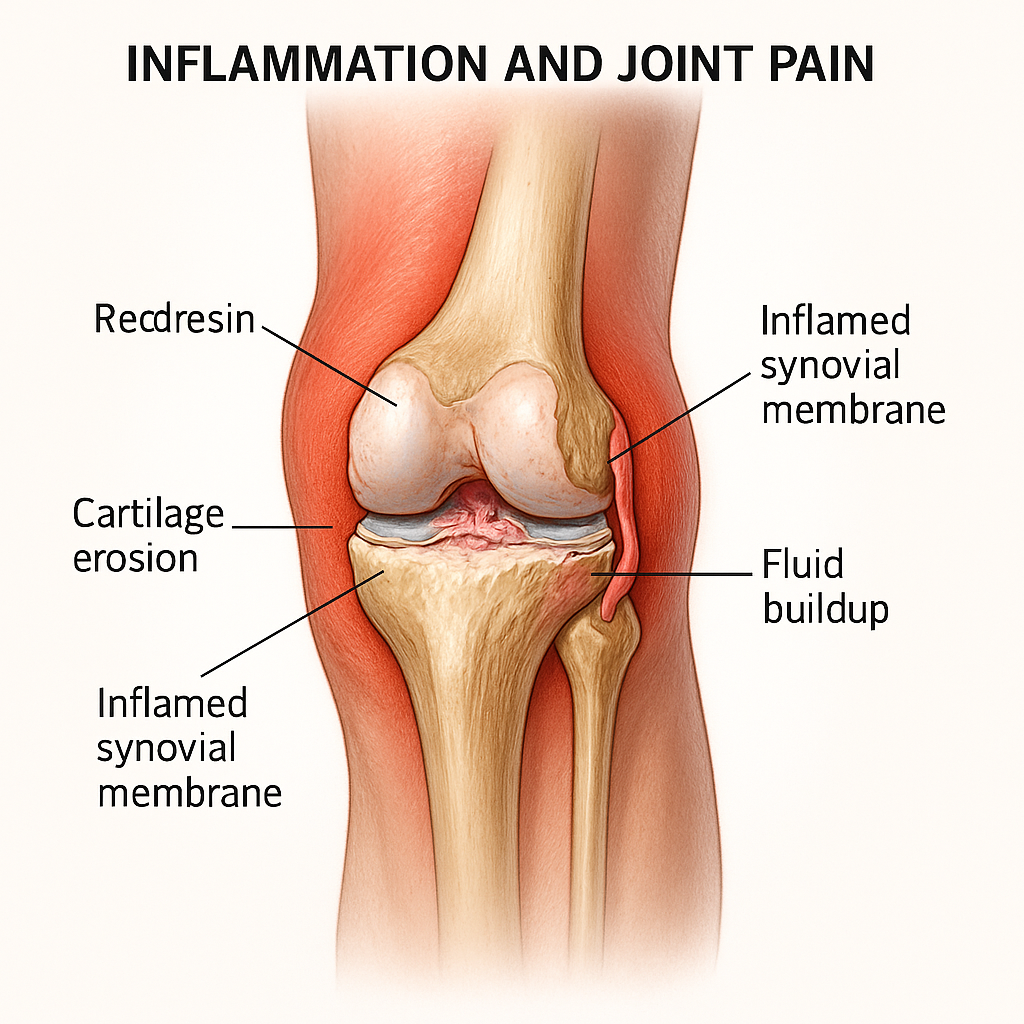How Elevated Inflammation Can Cause Joint Pain

Many patients come to our clinic frustrated by joint pain. They’ve tried over-the-counter pain relievers, physical therapy, and even injections—only to have the aches return. What many don’t realize is that the root cause isn’t always wear-and-tear or injury. Sometimes, the real culprit is elevated inflammation throughout the body.
At Sheen Vein (Aesthetics and Functional Medicine) in St. Louis, we often see people with chronic joint discomfort who have underlying systemic inflammation driving their symptoms. Understanding this connection can be the key to lasting relief.
What Is Inflammation?
Inflammation is your body’s natural defense mechanism. When you injure yourself or fight off an infection, your immune system sends chemical signals and immune cells to the affected area. This short-term, or acute, inflammation is necessary for healing.
The problem occurs when inflammation becomes chronic—lingering for weeks, months, or even years. Instead of protecting you, it starts damaging healthy tissues, including cartilage, ligaments, and the lining of your joints.
How Elevated Inflammation Damages Joints
When your body is in a state of high inflammation, your immune system releases chemicals called cytokines. These cytokines can:
- Break down cartilage, the smooth tissue that cushions joints
- Increase joint swelling and stiffness
- Sensitize nerve endings, making pain signals more intense
- Reduce the production of synovial fluid, which lubricates joints
Over time, this process can cause or worsen conditions like osteoarthritis, rheumatoid arthritis, and other inflammatory joint disorders. Even without a formal arthritis diagnosis, ongoing inflammation can cause noticeable joint discomfort.
Signs Your Joint Pain May Be Inflammation-Related
While imaging tests like X-rays can show cartilage damage, inflammation often shows itself in symptoms:
- Morning stiffness that lasts more than 30 minutes
- Aching in multiple joints, not just one injured area
- Pain that improves with gentle movement but worsens with inactivity
- Episodes of swelling, warmth, or redness around joints
- Fatigue, brain fog, or other whole-body symptoms
These clues suggest that your joint pain isn’t just mechanical—it’s part of a larger inflammatory process.
Common Triggers of Elevated Inflammation
A high total level of inflammation often comes from a combination of lifestyle, environmental, and medical factors, including:
- Poor diet: Excess sugar, refined carbs, and processed foods can promote inflammatory pathways.
- Hidden infections: Chronic gum disease, sinus infections, or gut dysbiosis can fuel inflammation.
- Autoimmune disorders: Conditions like rheumatoid arthritis or lupus involve overactive immune responses.
- Obesity: Fat cells produce inflammatory chemicals, especially around the abdomen.
- Toxin exposure: Heavy metals, pesticides, and other pollutants can disrupt immune balance.
- Chronic stress: Prolonged cortisol imbalance can worsen inflammatory responses.
The Functional Medicine Approach to Joint Pain
In traditional medicine, joint pain from inflammation is often managed with anti-inflammatory drugs or corticosteroid injections. While these can provide temporary relief, they don’t address the root cause.
In our St. Louis functional medicine clinic, we take a deeper approach:
- Advanced Testing – We measure markers like CRP (C-reactive protein), ESR (erythrocyte sedimentation rate), and cytokine levels to determine your inflammation load.
- Root Cause Investigation – We evaluate diet, gut health, immune function, and toxin exposure to identify why inflammation is elevated.
- Targeted Nutrition – Anti-inflammatory diets rich in omega-3s, antioxidants, and phytonutrients can dramatically reduce inflammation over time.
- Lifestyle Optimization – Sleep, movement, and stress management all play a role in calming inflammation.
- Regenerative Therapies – For certain cases, treatments like platelet-rich fibrin (PRF) or photobiomodulation can promote healing in inflamed joints.
Nutrition’s Role in Lowering Inflammation
Certain foods can help fight inflammation naturally:
- Fatty fish (salmon, sardines, mackerel) for omega-3 fatty acids
- Berries and leafy greens for antioxidants
- Turmeric for curcumin, a potent anti-inflammatory compound
- Olive oil and nuts for healthy fats
On the other hand, reducing processed foods, sugary snacks, and excessive alcohol can make a noticeable difference in how your joints feel.
When to Seek Medical Help
If you’ve had joint pain for more than a few weeks—especially if it’s in multiple areas or accompanied by swelling or fatigue—it’s worth getting your inflammation levels checked. The earlier we identify and address the cause, the better the outcome for your joints and overall health.
Bottom Line
An elevated total level of inflammation can silently wear down your joints, even if you’ve never had a major injury. By addressing the underlying causes and calming the immune system, you can reduce pain, improve mobility, and protect your joints for years to come.
At Sheen Vein (Aesthetics and Functional Medicine), we take a comprehensive approach to inflammation-driven joint pain—helping you move better, feel stronger, and live with less discomfort.
Ready to get to the root of your joint pain?
Learn more about our Functional Medicine services »
Schedule your consultation today »